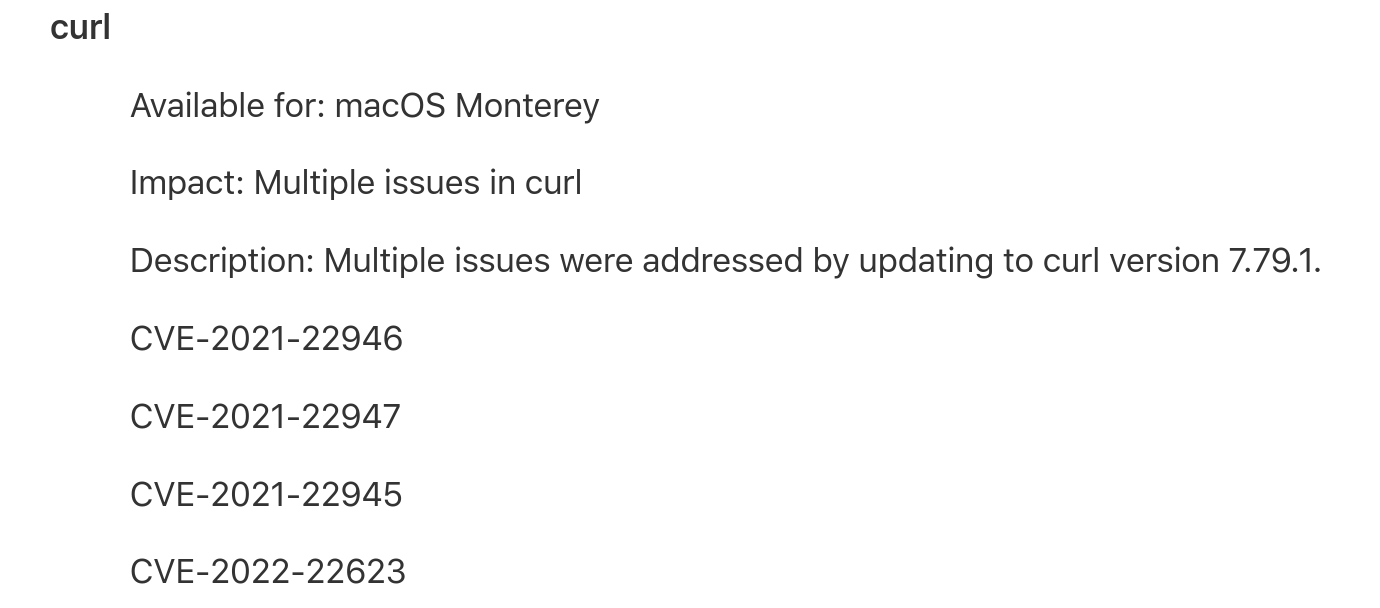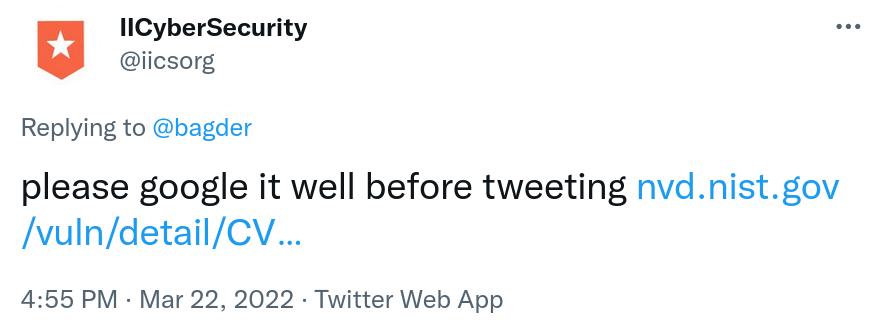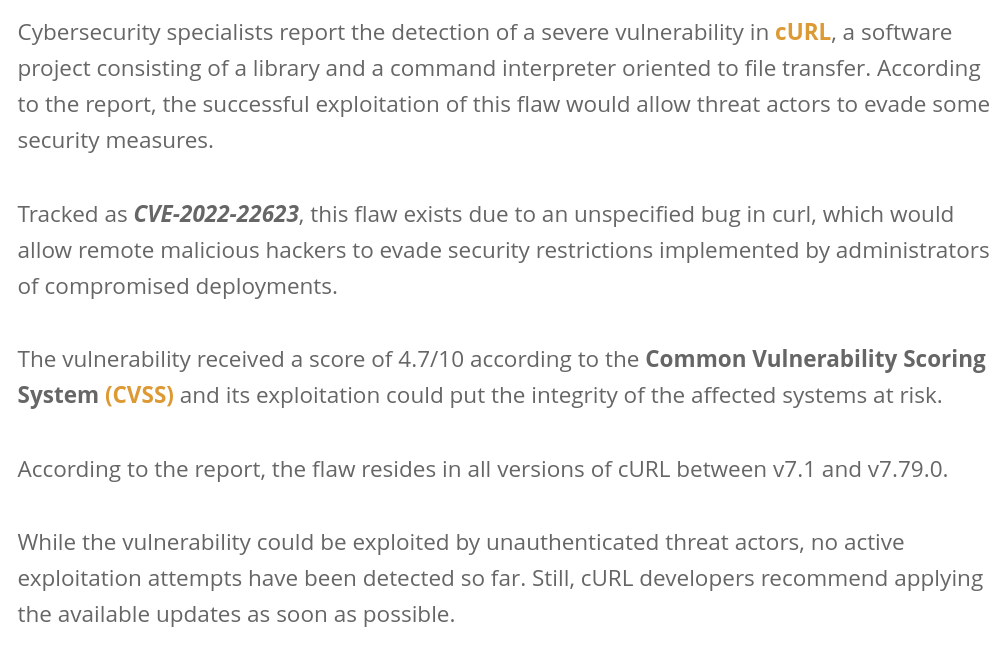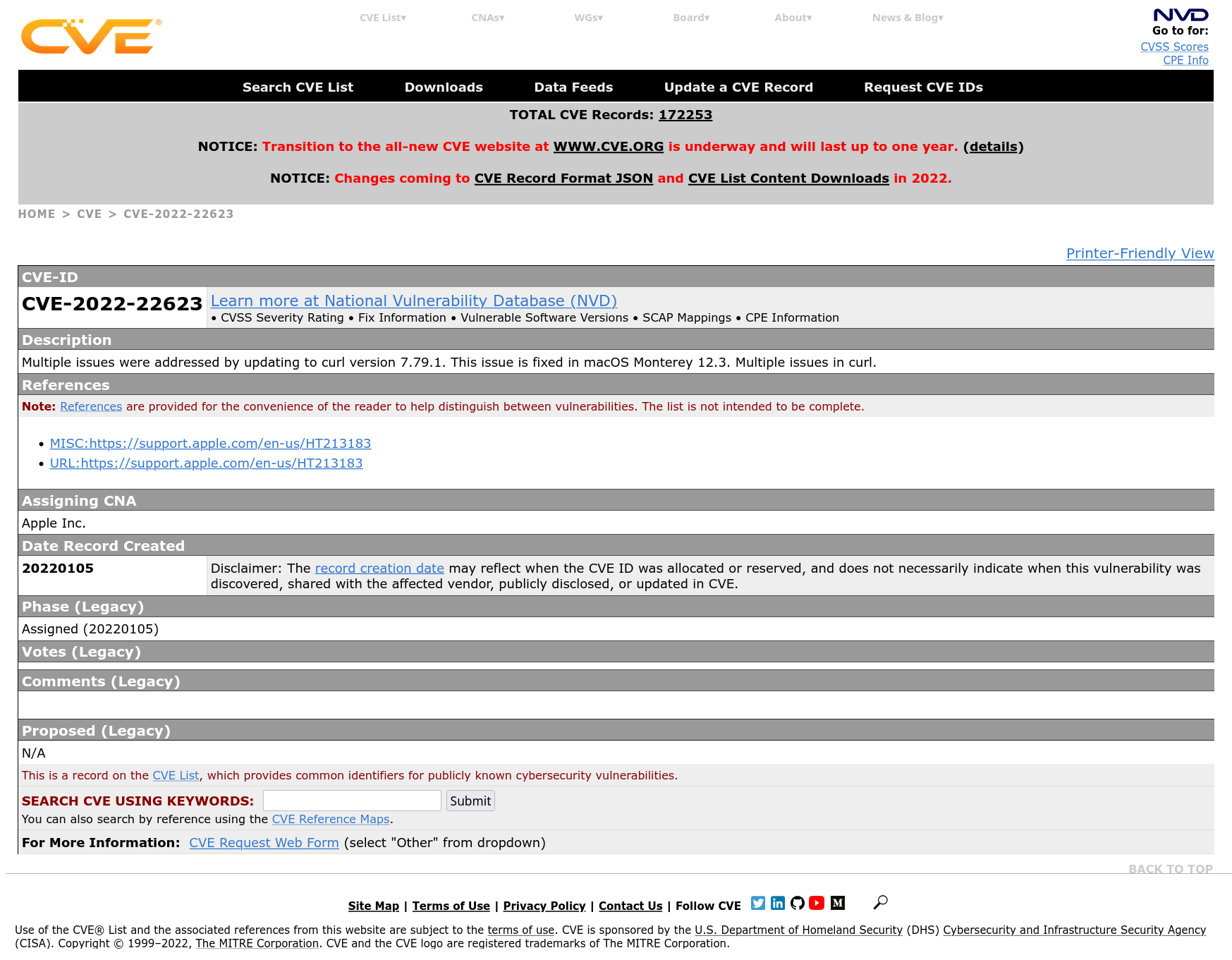“The Lord giveth and the Lord taketh away.”
Job 1:21
On March 16 2022, the curl security team received an email in which the reporter highlighted an Apple web page. What can you tell us about this?
I hadn’t seen it before. On this page with the title “About the security content of macOS Monterey 12.3”, said to have been published just two days prior, Apple mentions recent package upgrades and the page lists a bunch of products and what security fixes that were done for them in this update. Among the many products listed, curl is mentioned.
This is what the curl section of the page looked like:

In the curl project we always make all CVEs public with as much detail as we can possibly extract and provide about them. We take great pride in being the best in class in security flaw information and transparency.
Apple listed four CVE fixed. The three first IDs we immediately recognized from the curl security page. The last one however, was a surprise. What was that?
CVE-2022-22623
This is not a CVE published by the curl project. The curl project has in fact not shipped any CVE at all in 2022 (yet) so that’s easy to spot. When we looked at the MITRE registration for the ID, it also didn’t disclose any clues really. Not that it was expected to. It did show it was created on January 5 though, so it wasn’t completely new.
Was it a typo?
I compared this number to other recent CVE numbers announced from curl and I laid eyes on CVE-2021-22923 which had just two digits changed. Did they perhaps mean that CVE?
The only “problem” with that CVE is that it was in regards to Metalink and I don’t think Apple ever shipped their curl package with metalink support so therefore they wouldn’t have fixed a Metalink problem. So probably not a typo for that number at least!
I reached out to a friend at Apple as well with an email to Apple Product Security.
Security is our number one priority
In the curl project, we take security seriously. The news that there might be a security problem in curl that we haven’t been told about and that looks like it was about to get public sooner or later was of course somewhat alarming and something we just needed to get to the bottom of. It was also slightly disappointing that a large vendor and packager of curl since over 20 years would go about it this way and jab this into our back.
No source code
Apple has not made the source code for their macOS 12.3 version and the packages they use in there public, so there was no way for us to run diffs or anything to check for the exact modifications that this claimed fix would’ve resulted in.
Apple said so
Several “security websites” (the quotes are there to indicate that clearly these sites are more security in the name than in reality) immediately posted details about this “vulnerability”. Some of them with CVSS scores and CWE numbers , explaining how this problem can hurt users. Obviously completely made up since none of that info was made available by any first party sources anywhere. Not from Apple and not from the curl project. If you now did a web search on that CVE number, several of the top search results linked to such sites providing details – obviously made up from thin air.
As I think these sites don’t add much value to humanity, I won’t link to them here but instead I will show you a screenshot from such an article to show you what a made up CVE number posted by Apple can make people claim:
At 23:28 (my time zone) on the 17th, my Apple friend responded saying they had forwarded the issue to “the right team”.
The Apple Product Security team I also emailed about this issue, answered at 00:23 (still my time) on the 18th saying “we are looking into this and will provide an update soon when we have more information.”
The MITRE page got more details
After the weekend passed with no response, I looked back again on the MITRE page for the CVE in question and it had then gotten populated with additional curl details; mentioning Apple as CNA and now featuring links back to the Apple page! Now it really started to look like the CVE was something real that Apple (or someone) had registered but not told us about. It included real curl related snippets like this:
Multiple issues were addressed by updating to curl version 7.79.1. This issue is fixed in macOS Monterey 12.3. Multiple issues in curl.
Please tell us more details
On Monday the 21st, I continued to get questions about this CVE. Among others, from a member of a major European ISP’s CERT team curious about this CVE as they couldn’t find any specific information about this issue either and they were concerned they might have this vulnerability in the curl versions they run. They of course (rightfully) assumed that I would know about curl CVEs.
It turns out that when a major company randomly mentions a new CVE, it actually has an impact on the world!
Gone!
At around 20:30 on March 21st, someone on Twitter spotted that the ghost CVE had been removed from Apple’s web page and it only listed three issues (and a mention that the section had been updated). At 21:39 I get an email response from Apple Product Security:
Thank you for reaching out to us about the error with this CVE on our security advisory. We’ve updated our site and requested that MITRE reject CVE-2022-22623 on their end.
Please let us know if you have any questions.
The reject request to MITRE is expected to be slow so that page will remains showing the outdated data for a while longer.
Exploit one
When Apple had retracted the wrong CVE, I figured I should maybe try to get exploitone.com to remove their “article” to maybe at least stop one avenue of further misinformation about this curl “issue”. I tweeted (in perhaps a tad bit inflammatory manner):
I get the feeling they didn’t quite understand my point. They replied:

What happened?
As I had questions about Apple’s mishap, I replied (sent off 22:28 on the 21st, still only early afternoon on the US west coast), asking for details on what exactly had happened here. If it was a typo, then how come it got registered with MITRE? It’s just so puzzling and mysterious!
When I’m posting this article on my blog (36 hours after I sent the question), I still haven’t gotten any response or explanation. I don’t expect to get any either, but if I do, I will update this post accordingly.
Update March 26
exploitone.com updated their page at some point after my tweet to remove the mention of the imaginary CVE, but the wording remains very odd:






